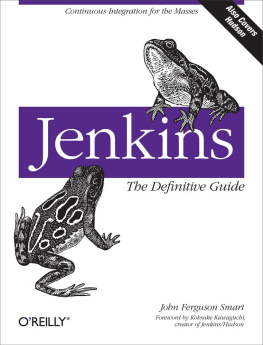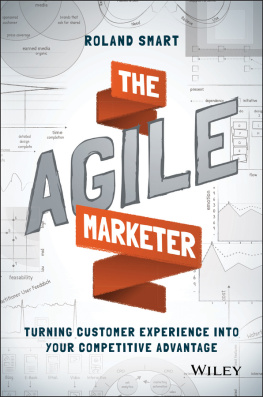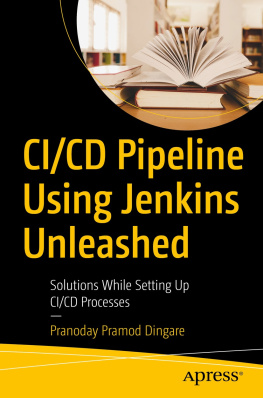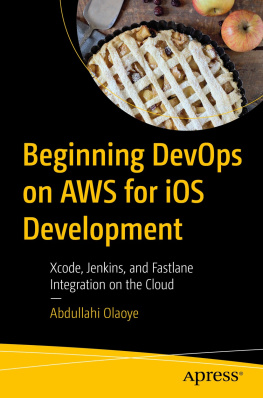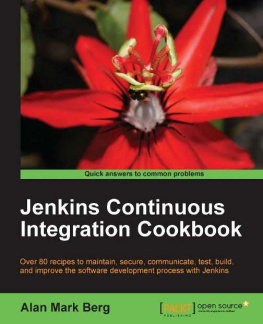Smart - Jenkins: The Definitive Guide
Here you can read online Smart - Jenkins: The Definitive Guide full text of the book (entire story) in english for free. Download pdf and epub, get meaning, cover and reviews about this ebook. City: Sebastopol, year: 2011, publisher: OReilly Media, genre: Computer. Description of the work, (preface) as well as reviews are available. Best literature library LitArk.com created for fans of good reading and offers a wide selection of genres:
Romance novel
Science fiction
Adventure
Detective
Science
History
Home and family
Prose
Art
Politics
Computer
Non-fiction
Religion
Business
Children
Humor
Choose a favorite category and find really read worthwhile books. Enjoy immersion in the world of imagination, feel the emotions of the characters or learn something new for yourself, make an fascinating discovery.
- Book:Jenkins: The Definitive Guide
- Author:
- Publisher:OReilly Media
- Genre:
- Year:2011
- City:Sebastopol
- Rating:3 / 5
- Favourites:Add to favourites
- Your mark:
- 60
- 1
- 2
- 3
- 4
- 5
Jenkins: The Definitive Guide: summary, description and annotation
We offer to read an annotation, description, summary or preface (depends on what the author of the book "Jenkins: The Definitive Guide" wrote himself). If you haven't found the necessary information about the book — write in the comments, we will try to find it.
Learn how to automate your build, integration, release and deployment process with Jenkins, the popular Java-based open source tool that has revolutionized the way teams think about continuous integration (CI). This concise guide shows you how to seamlessly include Jenkins in the development processand demonstrates how CI can save you time, money, and many headaches.
Jenkins: The Definitive Guide — read online for free the complete book (whole text) full work
Below is the text of the book, divided by pages. System saving the place of the last page read, allows you to conveniently read the book "Jenkins: The Definitive Guide" online for free, without having to search again every time where you left off. Put a bookmark, and you can go to the page where you finished reading at any time.
Font size:
Interval:
Bookmark:

Beijing Cambridge Farnham Kln Sebastopol Tokyo
If you purchased this ebook directly from oreilly.com, you have the following benefits:
DRM-free ebooksuse your ebooks across devices without restrictions or limitations
Multiple formatsuse on your laptop, tablet, or phone
Lifetime access, with free updates
Dropbox syncingyour files, anywhere
If you purchased this ebook from another retailer, you can upgrade your ebook to take advantage of all these benefits for just $4.99. to access your ebook upgrade.
Please note that upgrade offers are not available from sample content.
Seven years ago, I wrote the first line of code that started this whole project that is now known as Jenkins, and was originally called Hudson. I used to be the guy who broke the build, so I needed a program to catch my mistakes before my colleagues did. It was just a simple tool that did a simple thing. But it rapidly evolved, and now Id like to think that its the most dominant CI server on the market bar none, encompassing a broad plugin ecosystem, commercial distributions, hosted Jenkins-as-a-Service, user groups, meet-ups, trainings, and so on.
As with most of my other projects, this project was open-sourced since its inception. Over its life it critically relied on the help and love of other people, without which the project wouldnt be in the current state. During this time Ive also learned a thing or two about running open source projects. From that experience, I think people often overlook that there are many ways to help an open source project, of which writing code is just one of many. Theres spreading words, helping other users, organizing meet-ups, and yes, theres writing documentation.
In this sense, John is an important part of the Jenkins community, even though he hasnt contributed codeinstead, he makes Jenkins more approachable to new users. For example, he has a popular blog thats followed by many, where he regularly talks about continuous integration practices and other software development topics. He is good at explaining things so that people new to Jenkins can still understand them, which is something often hard for people like me who develop Jenkins day in day out. He is also well-known for his training courses, of which Jenkins is a part. This is another means by which he makes Jenkins accessible for more people. He clearly has a passion for evangelizing new ideas and teaching fellow developers to be more productive.
These days I spend my time at CloudBees where I focus my time on Open Source Jenkins, the CloudBees pro version of Jenkins where we build plugins on top of Jenkins, and taking Jenkins to the private and public cloud with CloudBees DEV@cloud service. In this role I now have more interaction with John than before, and my respect for his passion has only grown.
So I was truly delighted that he took on the daunting task of writing a book about Jenkins. It gives a great overview of the typical main ingredients of continuous integration. And for me personally, I always get asked if theres a book about Jenkins, and I can finally answer this question positively! But more importantly, this book reflects his passion, and his long experience in teaching people how to use Jenkins, in combination with other things. But dont take my words for it. Youll just need to read on to see it for yourself.
This book is aimed at relatively technical readers, though no prior experience with Continuous Integration is assumed. You may be new to Continuous Integration, and would like to learn about the benefits it can bring to your development team. Or, you might be using Jenkins or Hudson already, and want to discover how you can take your Continuous Integration infrastructure further.
Much of this book discusses Jenkins in the context of Java or JVM-related projects. Nevertheless, even if you are using another technology stack, this book should give you a good grounding in Continuous Integration with Jenkins. We discuss how to build projects using several non-Java technologies, including as Grails, Ruby on Rails and .NET. In addition, many topics, such as general configuration, notification, distributed builds and security are applicable no matter what language you are using.
Continuous Integration is like a lot of things: the more you put in, the more value you will get out. While even a basic Continuous Integration setup will produce positive improvements in your team process, there are significant advantages to gradually assimilating and implementing some of the more advanced techniques as well. To this end, this book is organized as a progressive trek into the world of Continuous Integration with Jenkins, going from simple to more advanced. In the first chapter, we start off with a sweeping overview of what Jenkins is all about, in the form of a high-level guided tour. From there, we progress into how to install and configure your Jenkins server and how to set up basic build jobs. Once we have mastered the basics, we will delve into more advanced topics, including automated testing practices, security, more advanced notification techniques, and measuring and reporting on code quality metrics. Next, we move on to more advanced build techniques such as matrix builds, distributed builds and cloud-based CI, before discussing how to implement Continuous Deployment with Jenkins. Finally, we cover some tips on maintaining your Jenkins server.
As we discuss in the introduction, Jenkins was originally, and up until recently, known as Hudson. In 2009, Oracle purchased Sun and inherited the code base of Hudson. In early 2011, tensions between Oracle and the open source community reached rupture point and the project forked into two separate entities: Jenkins, run by most of the original Hudson developers, and Hudson, which remained under the control of Oracle.
As the title suggests, this book is primarily focused on Jenkins. However, much of the book was initially written before the fork, and the products remain very similar. So, although the examples and illustrations do usually refer to Jenkins, almost all of what is discussed will also apply to Hudson.
This book follows certain conventions for font usage. Understanding these conventions up-front makes it easier to use this book.
Used for filenames, file extensions, URLs, application names, emphasis, and new terms when they are first introduced.
Constant widthUsed for Java class names, methods, variables, properties, data types, database elements, and snippets of code that appear in text.
Constant width boldUsed for commands you enter at the command line and to highlight new code inserted in a running example.
Constant width italicUsed to annotate output.
From time to time, this book discusses command-line instructions. When we do, output produced by the console (e.g., command prompts or screen output) is displayed in normal characters, and commands (what you type) are written in bold. For example:
Font size:
Interval:
Bookmark:
Similar books «Jenkins: The Definitive Guide»
Look at similar books to Jenkins: The Definitive Guide. We have selected literature similar in name and meaning in the hope of providing readers with more options to find new, interesting, not yet read works.
Discussion, reviews of the book Jenkins: The Definitive Guide and just readers' own opinions. Leave your comments, write what you think about the work, its meaning or the main characters. Specify what exactly you liked and what you didn't like, and why you think so.

